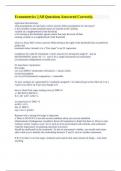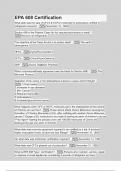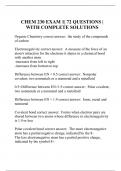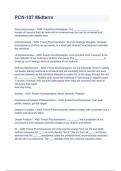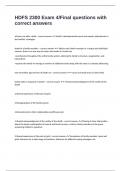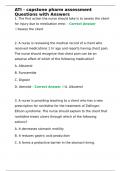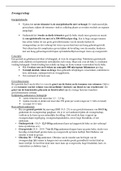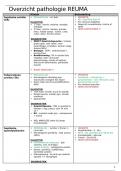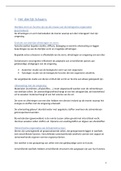regression discontinuity:
what assumptions are necessary correct answers What assumptions are necessary?
o All variables except treatment status are smooth in the running
variable in a neighborhood of the threshold.
o No sorting at the threshold: agents cannot fine tune the level of their
running variable in a neighborhood of the threshold
what is a fuzzy RD? correct answers When being to the right of the threshold does not perfectly
predict the
treatment status; instead, it is a "first stage" in an IV regression.
Conditions for valid IV estimation: correct answers (1) strong first stage [F‐stat on
INSTRUMENTs alone>10 -->t‐stat>3 for a single instrument] on instrument
(2) instrument independent of model error
IV must have 2 properties:
first stage:
cov (x,z) DNE 0- (instrument relevance)--> always check
second assumption:
cov (u,z)=0 (instrument exogeneity)--> untestable
IV uses variation in x generated by "randomly assigned" z to indirectly get at the effect of x on y
* gives you effect on Y per unit change in X
how to check first stage: testing cov(x,z) DNE=0
y= B0+B1X1+B2X2+u
X1= π0+ π2Z+ π2X2+ e
we must have π1 DNE= 0
so H0= π1=0
Ha: π1 DNE 0
reg x on z's, predict
Reasons why a strong first stage is important
o There is NO WAY to test the second condition when you are just identified
(#instruments=#endogenous variables). Resist all temptation to think that there is. There is only
evidence which "makes a case" for it, such as Z be uncorrelated with controls, and sometimes
"placebo regressions" (examining outcomes you know
should be unaffected by the treatment). To test an instrument's validity, you would need some
other valid way to identify the relationship between Y and X, such as another instrument.
if R^2=0, there is no first stage- treatment and control took same amount of drugs, - can't learn
anything
,if no first stage- R^2 in denominator small and std error/confidence intervals blow up
Why is a strong first stage important: (a) for bias reasons (b) for precision
reasons correct answers - effect of instrument on (x)- need strong first stage because weak first
stage magnifies bias in IV and will lead to large SEs in our IV estimates
IV sacrifices precision to reduce Bias- LArger SEs than OLS--> we want to use OLS, but can
only if cov (x,u)=0 holds
since R^2<1, IV standard errors are always larger than OLS, however IV is consistent while OLS
is inconsistent when cov (x,u) DNE - and cov(z,u)= 0
the more instruments you are using the larger the first F-stat on instruments should be- need
higher standard of evidence
What problems does IV deal with? How do IV standard errors compare to OLS? correct answers
Iv methods deal with - OVB, ME in X and simultaneity
IV standard errors larger than OLS and Iv sacrifices precision to reduce bias
- good for OVB-
example- people who take drugs might be different in ways that affect outcome- contamination
of RCT- use instrumental variables
ideally z is randomly assigned!
IV used in situations where you have a natural experiment on Z which also affects x and you are
really interested in the effect of x on y- IV estimate gives you effect on y per unit change in x
Iv estimation can also be used to eliminate attenuation due to measurement error- second report
of x used as instrument for first report of x- if two reports are independent (uncorrelated) then
second report is by defining uncorrelated with source of attenuation bias
ME attenuates the first stage and reduced form by the same factor lambda, so IV divides it out!
only gets ride of attenuation bias if Instrument not correlated with measurement error classical
ME
when IV estimates larger in magnitude than OLS one reason can be because IV is getting ride of
attenuation bias
interpretations of IV> OLS correct answers attenuation bias caused by ME making OLS smaller
than truth,
first stage is weak
reduced form- partly driven by third factors besides instrument( validity condition fails)
- IV estimates a local average treatment effect LATE the effect for those whose education
decision influenced by instrument- only those at margin
- Late is untestable assumption- no requires monotonicity that nobody is pushed in wrong
direction- causal effect only for subset of people who can be induced to change behavior because
of instrument
, What is the "reduced form" (also known in some contexts as the "intention to
treat" estimates)?
o What can it be used to test? correct answers reduced form is cov(u,
OLS reg of y on z
called intention to treat
tests if there is an effect
tells us whether IV estimate is significantly different from zero
if instrument is valid- reduced form only supposed to be driven by instruments relationship to
treatment- does not always hold
there can only be a nonzero IV estimate if there is a nonzero reduced form!
reduced form is a sufficient stat for whether there is any non-zero iv estimate
having a first stage is critical for valid IV estimation
* new if you have a valid instrumental variable, testing the reduced form relationship with the
instrument is sufficient to answer - is there a causal effect of x on y even when first stage is weak
bu not zero
the standard errors on an IV estimate correct answers e- IV standard errors are always larger than
OLS since R^2<1, std error in IV case differs from OLs only in the R^2 (first regression of x on
z( in the denominator
- however OLS is inconsistent and IV is consistent, IV sacrifices precision to reduce bias
motive for control contain or hausman test if OLS is not different than IV use OLS
Different forms of IV
o IV
o Indirect least squares (when can you do it). Be ready to compute IV
estimates this way
o Two‐stage least squares correct answers 3 equivalent ways:
4 including control function- all give exactly same slope estimates as IV
IV: cov(x,y)/var(x,z)
ILS - ratio of two OLS slope coefficients, indirect least squares (ratio of difference also known
as wald estimator)
cov(y,z)/ cov(x,z)
IV= ILS when only one instrument
IV= reduced form/ first stage regression= OLS reg of y on z / OLS reg of x on Z (and other
controls)
when instrument z is continuous (not dummy for treatment= can't use ratio of difference form)...
2SLS- two stage least squares
- more efficient than IV but increase in bias
- basically a more general way of thinking about IV
- using variance in x induced by z to determine impact on y


